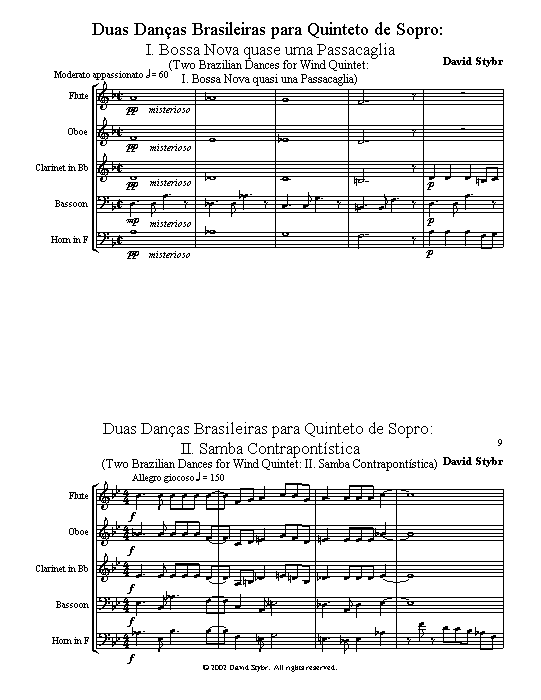Back * Home * Next * Commentary * Scores
| |
|
|
|
| |
David Stybr: Two Brazilian Dances for Wind Quintet (8:00)
|
| |
|
|
Click the score to see and hear audio versions

Click the score to see and hear audio versions
|
Return to Top
David Stybr: Engineer and Composer
It's Left Brain vs. Right Brain: best 2 falls out of 3
Português:
Duas Danças Brasileiras para Quinteto de Sopro (8:00):
I. Bossa Nova quase uma Passacaglia (3:35)
II. Samba Contrapontística (4:20)
[English: Two Brazilian Dances for Wind Quintet (8:00)]
Right Brain: "Heat waves turned my gaze to Brazil for inspiration, so this music complements my Argentine Tango Nostálgico. What began as a Samba for saxophone quartet grew to the point that I added a Bossa Nova as a preludio. Then counterpoint sprouted, so it needed the richness of 5 distinct voices. But this wind quintet is very different from my music for brass quintet. Maybe you can explain just what the heck kind of music is this anyway?"
Left Brain: "Two Brazilian Dances for Wind Quintet (Duas Danças Brasileiras, in Portuguese) are a Bossa Nova and a Samba, with many other elements. Bossa Nova quase uma Passacaglia is built upon a repeated 4-bar chord progression and bass figure. A sultry 4-bar motif is varied, and grows into a 16-bar theme. The music evolves into a monothematic sonata movement which hovers between F Major and D Minor, with a simple development in G Minor."
Right Brain: "The exotic low ranges of flute and oboe made me wonder: how low can they go? Did you know that Bossa Nova was the mother of Casanova?"
Left Brain: "No, the Bossa Nova evolved from the Samba in the 1950s. Samba Contrapontística is a lively rondo in B-Flat Major, with a fugue in G Minor as a central development. Then both themes of the Samba are heard in counterpoint with each other and with the theme and bass pattern of the Bossa Nova. The keys of both pieces are frequently blurred by abundant chromaticism, but the music is essentially tonal."
Right Brain: "A fugue in a samba! Who'd 'a' thunk it? O Carnaval do Brasil em miniatura — meets the concert hall. Bossa Nova quase uma Passacaglia was completed in Lawrence, Kansas in May 2002, and Samba Contrapontística in Princeton, New Jersey in June 2002."
Back * Home * Next * Top * E-mail to David Stybr
